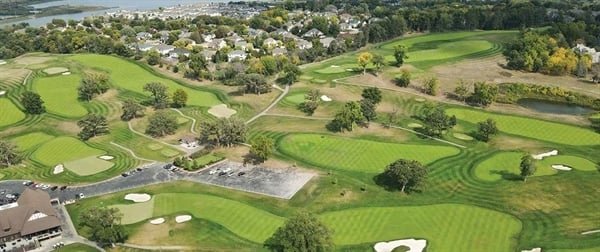Capan Misses Cut in Final Tour Event to Finish Rookie Season 127th in FedEx Cup Standings
SEA ISLAND, Ga. – Following the best individual performance during his rookie season on the PGA Tour last week, Minnesotan Frankie Capan missed the...

John A. Cole could not have imagined this.
Cole owned a milling company in Rochester, Minnesota, just as the century turned from 19th to 20th. Rochester was a modest city in 1900: 6,800 residents, dirt roads into and out of town—and only five holes of golf.
Today? It has about 115,000 residents, bustling asphalt highways like U.S. 52 and more golf holes than you could shake a hundred hickory sticks at.
The First of Many Courses
In early July 1900, Cole was elected president of the city's first golf club. “The ‘Silver Creek Golf Club' is now firmly established in this city,” the Rochester Post and Record reported. “The foundation stone has been laid, and the nucleus is formed from which a flourishing and prosperous club will grow.”
Silver Creek Golf Club was a five-hole course (later six), 1 1/2 miles east of downtown. The course lay on a pasture tended by sheep and goats, and it didn't last long. Nothing of golf is distinguishable now in the residential neighborhood.
Confusion exists over Silver Creek GC and Rochester Golf & Country Club, but they were not one and the same. The latter came along more than a decade after the debut of Silver Creek, and lay about 2 miles west of downtown.
Silver Creek carried at least a modicum of status. In August 1901, it became one of seven founding members of the Minnesota Golf Association. It almost certainly had vacated its creekside grounds by 1915, when the city's second course came along—Rochester Golf & Country Club.
A Successful Second
Rochester G&CC was born with pedigree and status. It lay on 100 acres leased by two Mayo Clinic physicians, who hired Red Wing Golf Club professional Harry Turpie, a native of St. Andrews, Scotland, to design a nine-hole course. In 1927, the course expanded to 18 holes, designed by famed golf architect A.W. Tillinghast.
Rochester G&CC's 18-hole layout was mostly open, yet it presented a challenge largely via Tillinghast's strategic bunkering. Noted golf writer Virginia Safford called the course “tougher than Interlachen.” Yet an extreme makeover lay ahead.
In the early 1930s, 30,000 pine trees were transplanted onto the playing grounds. Fully grown, the soaring conifers were sirens of danger.
That wooded iteration lasted for the better part of a century, until 2018 when the club underwent a restoration, headed by noted architects Brian Slawnik and Tom Doak. The intent was to return the course to its pre-1930s “Tillie” state, with wider fairways and larger greens.
Heading into 2024, fairways and greens have been regrassed. Grounds superintendent TJ Hauser said in January that he hopes the course will be ready for play by Memorial Day and that the new bentgrass should produce quicker green speeds and require less chemicals, fungicides and water, the latter by 25%-40%. “It's a financial savings, yes,” Hauser says, “but it's good for the environment, too.”
A Short, Walkable Course
Rochester's next golf course was another groundbreaker. In 1925, work began on an 18-hole layout just south of downtown. Memorial Field municipal, now known as Soldiers Field, opened that August. Still in operation today, it is tree-lined and relatively short (5,769 yards, tops)—a classic parkland course.
Ginny Anderson, a retired IBM worker who plays in a Rochester municipal women's league, finds Soldiers Field attractive because it is relatively short and walkable and, with its proximity to the Mayo Clinic and its regional and international clientele, offers a chance to play golf “with a whole different group of people, which is nice.”
Supporters of golf in Rochester recently helped rebuff attempts to have the course abandoned or shortened to nine holes. A $10 million outdoor aquatics center on the park's grounds is scheduled to open in 2024.
A Trio of Municipal Courses
Eventually, three more municipal courses were built: Eastwood, Northern Hills and Hadley Creek. Their histories, features and designs cut a broad swath. “We've got something for everybody,” says Jeff Gorman, lead pro at the Rochester munis.
Eastwood Golf Course, at the southeastern edge of the city and opened in 1964, offers distinctly different nines. The front nine is tree-lined with a “classic” feel, while the back is longer and more open, with large, undulating greens. It is “the nine everybody wants to play,” Gorman says. The back tees stretch to as much as 6,631 yards and feature the 605-yard, dogleg-right 14th, with a two-tiered green.
Northern Hills Golf Course, a mile off Highway 52 in the northwestern part of the city, opened in 1976 and lies between Soldiers Field and Eastwood for degree of difficulty, Gorman says. Hadley Creek Golf Course is a nine-hole, par-32 course with practice facilities.

SEA ISLAND, Ga. – Following the best individual performance during his rookie season on the PGA Tour last week, Minnesotan Frankie Capan missed the...

Players from Minnesota or with Minnesota connections:2025 PGA TOUR Pos. Name (Prev.) From Events Money won 48. Tom Hoge (48), Fargo, N.D., 29...

John Harrigan, 93, passed away at his home in Boynton Beach, Fla., November 15. Originally from Waterloo, Iowa, Harrigan graduated from Stillwater...